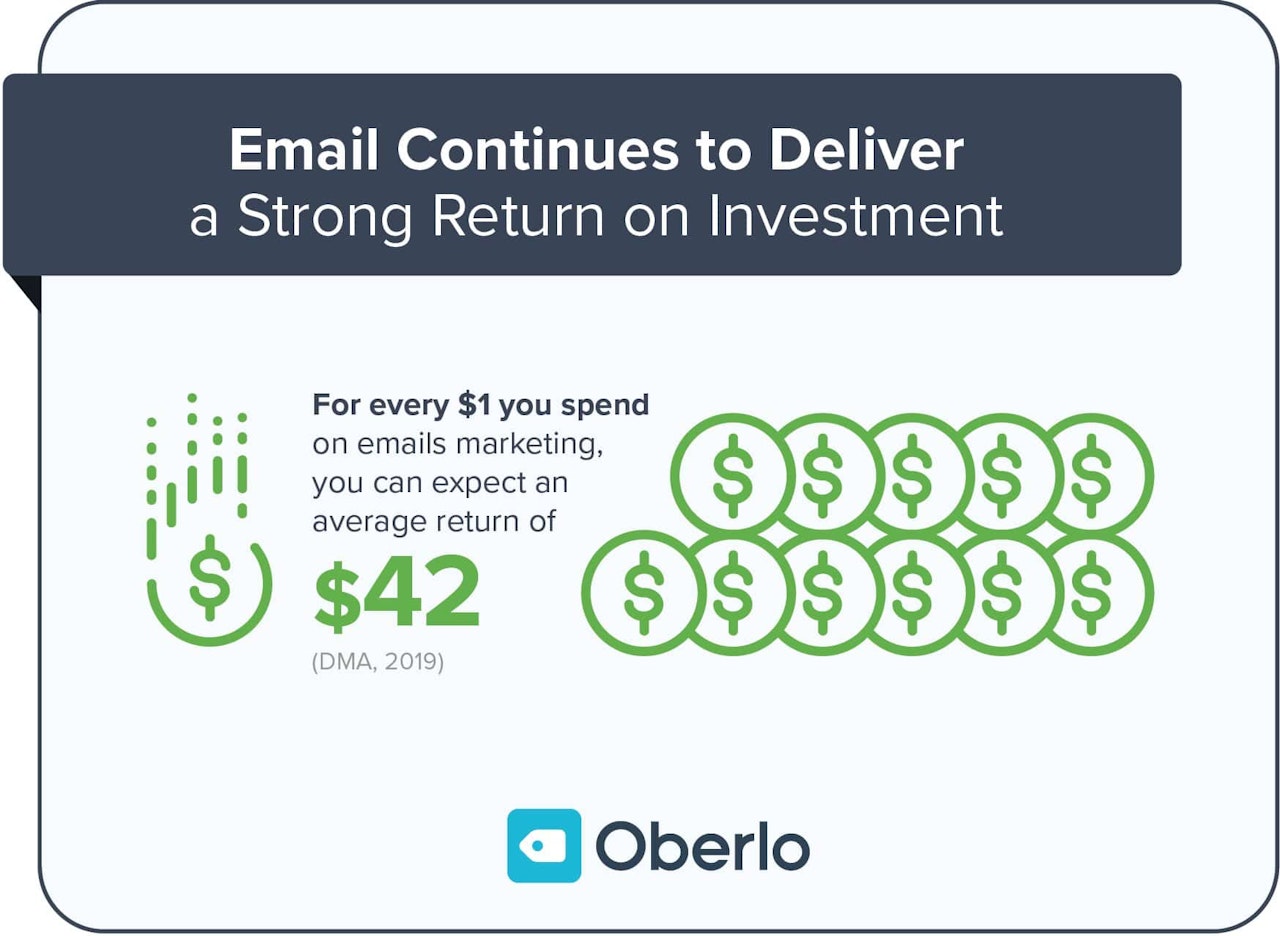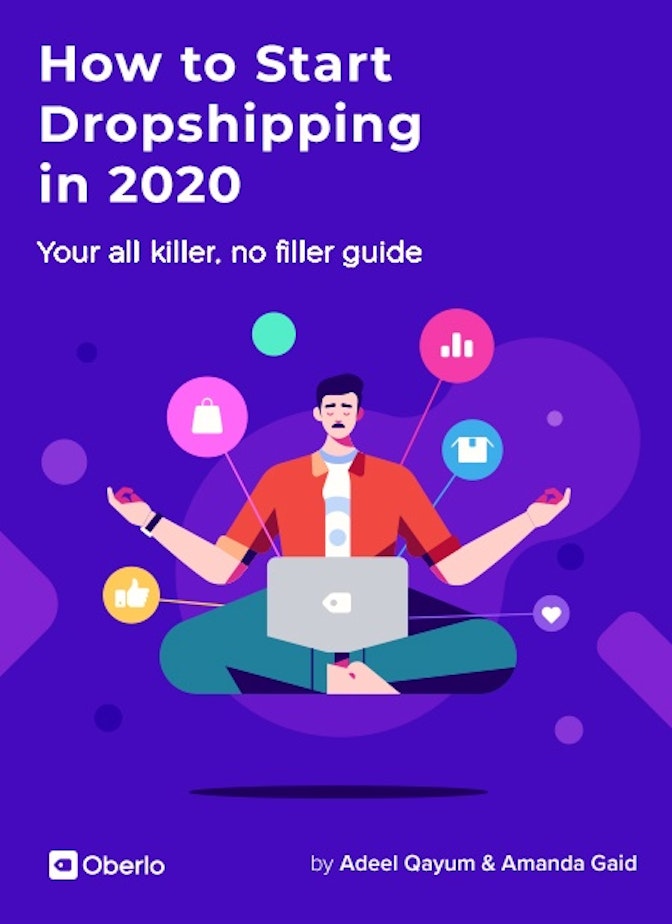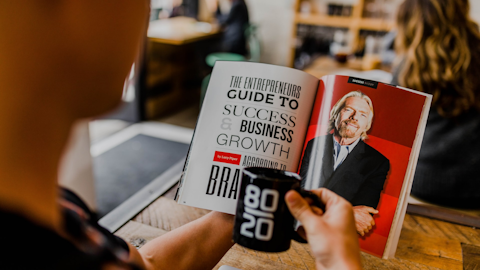Adeel here. You know you need to remind people about your new store. But you can’t afford to put more time and resources into Facebook ads.
Good news: there’s a cost-effective alternative available. And it gives you the ability to reach people in a place they visit daily – their inbox. 💻
Email marketing is a powerful strategy that will help you build a strong relationship with your customers and grow sales.
Never tried email marketing before? No problem. The steps below will teach you how to make profitable email campaigns from scratch.
But first – what is email marketing?
| 📖 Ecommerce Dictionary
email marketing: A marketing strategy where you send emails with commercial material to a list of people who have signed up for your email list. You can use it to offer discounts, tell people about a new product release, and more. This kind of marketing can help you engage people and increase sales over time. |
Check out this handy video to learn more:



How Does Email Marketing Work?
Email marketing can have many processes, but it usually works like this:
- You build a list of people who want to receive information about your brand
- People join your list by giving you their email addresses
- You use email to share information with these people
- People respond by engaging with the content inside your email
| 🕒 Tip Time
As a beginner, you can use email marketing tools to automate most of these steps. We’ll tell you all about it later in the chapter. |
Why Is Email Marketing Important?
→ Click Here to Launch Your Online Business with Shopify
Let’s look at some statistics that show the importance of email marketing.
As stated by the Direct Marketing Association, you can expect to get $42 for every $1 you spend on email marketing.
That’s incredible! 🤩 No other digital marketing channel offers such a high return on investment.
Simply put, email marketing is an affordable way to promote your store that gives you a really good ROI.
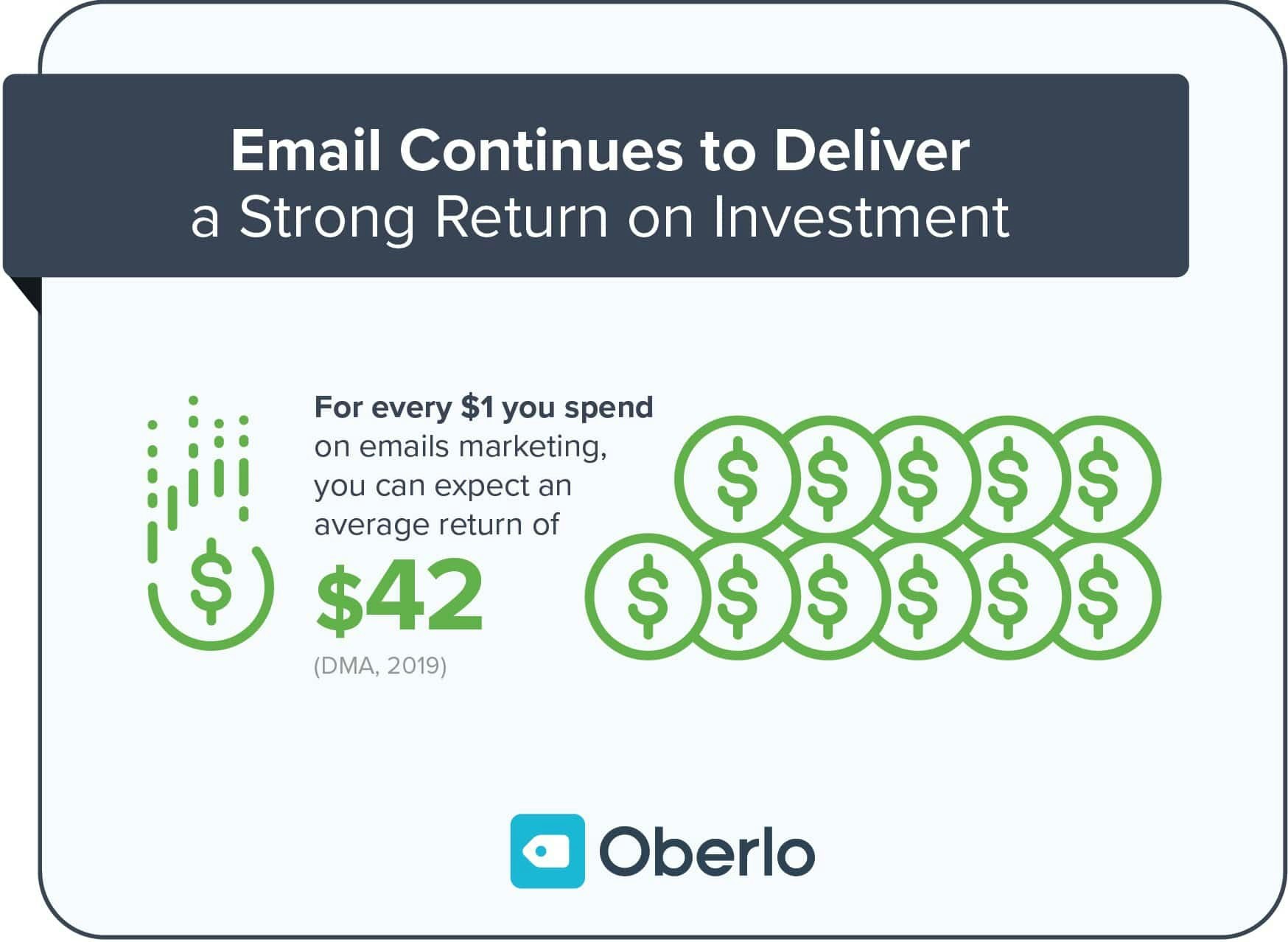
Benefits of an Email Marketing Strategy
When you focus on building an email marketing strategy that caters to your industry and audience, you can reap some serious benefits.
- Low costs. In comparison to other marketing channels like paid ads, running an email marketing campaign is one of the cheapest options.
- Huge reach. The nature and ease of email marketing means you can reach hundreds, thousands, or even millions of people just by clicking the “Send” button.
- High engagement. When you send emails to those who have voluntarily joined your list, you’re sending direct messages to people who are interested in your brand. This strategy is popular for generating quality engagement.
- More sales. Because your recipients are already interested, and you’re (hopefully) sending them targeted messages and offers, they’re more likely to make a purchase.
- Easy to implement. There are plenty of tools and platforms that can help you with developing, building, and launching an email marketing campaign without any coding expertise.
- Easy to measure. If you use tracking and measuring functionality, you can know exactly how each email is performing. Many email marketing campaign tools and platforms have this feature built-in.
| 🏆 From the Pros
Dropshipping pros Yuliya and Mike made $200,000 in their first year dropshipping. They credit part of the success to their experience in branding, customer service, and building customer loyalty. They believe email marketing isn’t just helpful – it’s necessary. “The beauty of email marketing is once you get a customer’s information, it’s yours to keep. Whereas with a platform like Facebook, you don’t have access to them anymore if Facebook shuts down. So an email is such a great asset for a business because it’s yours. Once you have that email, you can market to those people forever without paying the customer acquisition costs.” |
Getting Started With Email Marketing
In this section, I’ll break down the basics of everything from choosing an email marketing tool to the types of emails that you should be sending. So, grab your notebook, because things are about to get exciting.
- Choose an Email Marketing Tool
Before anything else, you’ll need to choose an email marketing tool that you’ll use to build your campaign. Luckily, Shopify has one built into its platform.
Called Shopify Email, the tool lets you create, launch and measure email campaigns right inside Shopify’s application.
Using existing brand creatives, customizable templates, and product visuals from your store, Shopify Email makes it extremely easy to launch your next campaign. Plus, you can send emails using your store’s domain name with no setup required.
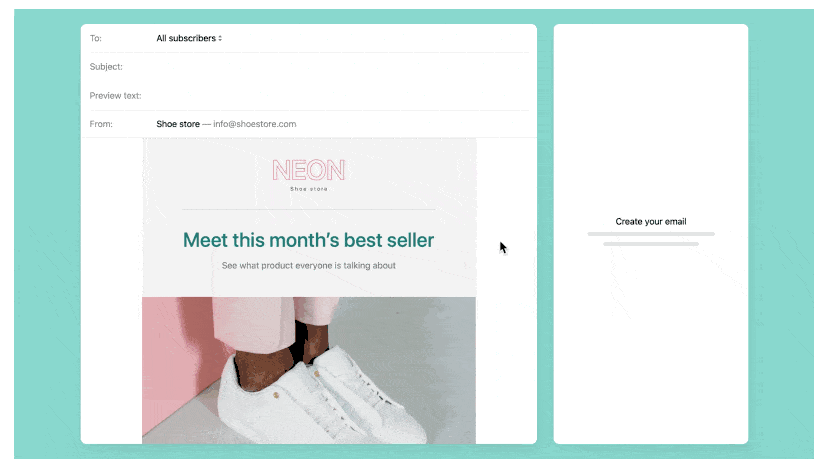
Note: As of this writing, Shopify Email is only available in a few countries. If you’re not seeing it in the Marketing section of your Shopify admin, consider using another email marketing tool for building your campaigns.
The Shopify App Store has plenty of tools to choose from. Some good options are:
- Klaviyo – offers a wide range of pre-built templates
- Privy – lets you display pop-ups, fly-outs, and more
- Seguno – seamlessly integrates with the Shopify admin and marketing
- Jilt – automatically syncs your existing contacts
Each of these tools offer a free plan that you can use to get started.
You’ll also want to make sure the tool you pick can handle your intended volume.
If you plan to send 1,000 emails a day to 100,000 subscribers, you don’t want to pick a tool that falls short of those numbers.
That said, you won’t have so many subscribers at the start. So a tool that offers a free trial or version should work until you build a bigger list.
| 🏆 From the Pros
Yuliya and Mike love email marketing tools too. “The good thing about email marketing is that it’s so accessible for every dropshipper as soon as you start, because there are amazing tools like Klaviyo that have templates already built-in. All you have to do is turn them on. They’re extremely conversion-driven and they work. Email marketing can sound intimidating, but it’s really so easy. Just use the automated email marketing flows, put your logo on it, and as time goes on, you can customize it and make it feel more like you.” |
- Build Your Email List
The simplest way to build an email list is to embed a pop-up form within your dropshipping website.
Typically, this is a small box that asks people to submit a few details including their email address, and it’s referred to as a pop-up form, opt-in form or web form.
You can set pop-up forms to appear for certain actions or at certain times. Plus, they let you display lead magnets, which is one of the most effective ways to get sign-ups.
| 📖 Ecommerce Dictionary
lead magnet: An offer or incentive that you give to potential customers in exchange for their email address. Ecommerce lead magnets usually have some kind of promotion, like a discount code, free gift, or giveaway. |
Most email marketing tools let you make pop-up forms to display on your website.
For example, Privy includes templates for designing announcement bars, exit-intent pop-ups (where pop-ups are presented to visitors leaving your site), and more.
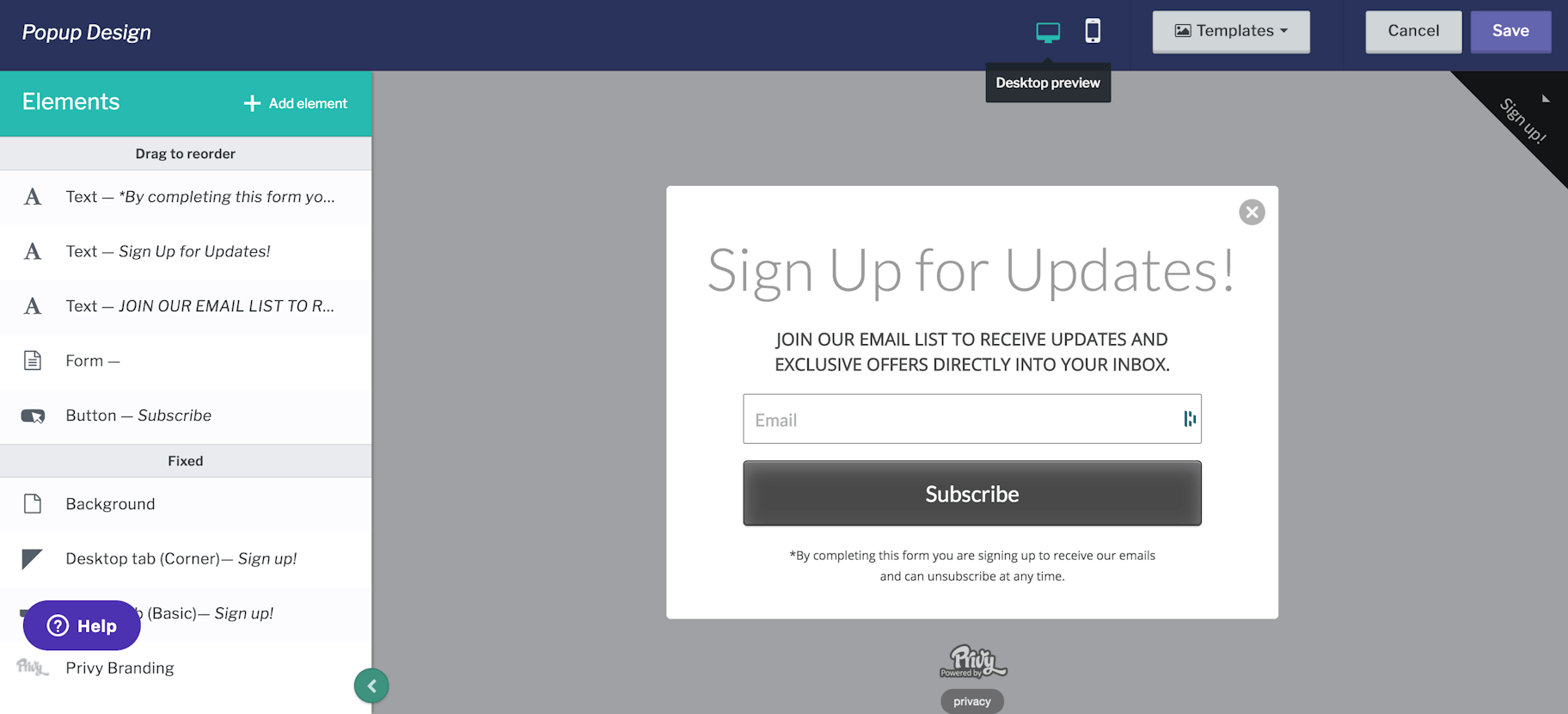
See if your email marketing tool lets you make pop-ups.
If it doesn’t, consider using pop-up tools like Sumo and JustUno. They’ll let you create pop-ups as well as integrate the collected emails into your email marketing software.
| 🕒 Tip Time
Making Pop-Up Forms That Work
|
Besides using pop-ups, you can use Shopify’s built-in newsletter form to collect people’s emails.
To collect emails from your site’s homepage, add a newsletter signup form to your store. Here’s how:
- Log into your Shopify account
- From the Shopify admin area, click the “Online store” menu and choose “Themes”
- At the top right corner, click the button that says “Customize Theme”
- In the submenu of the “Footer,” scroll down and tick the box for “Show newsletter sign-up”
- Click “Save”
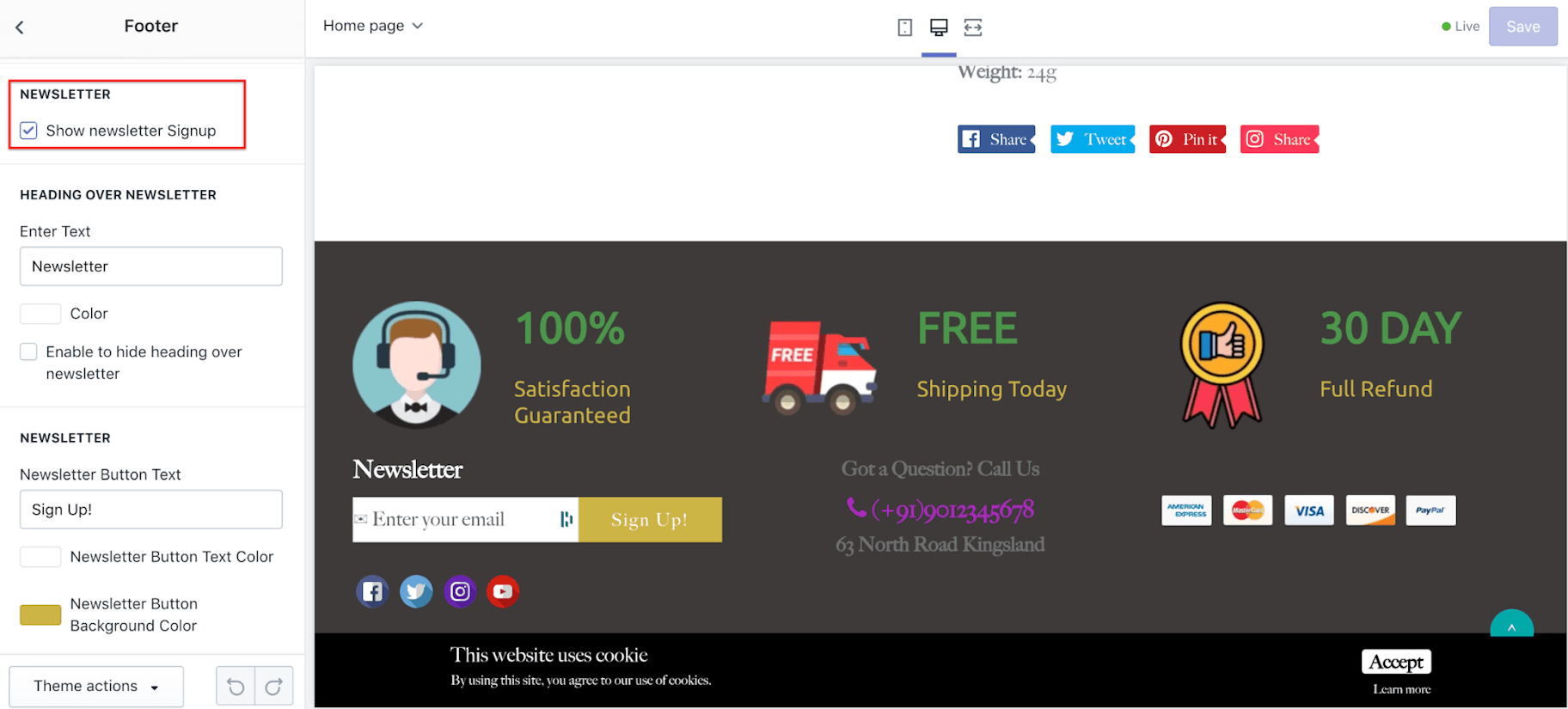
There’s also the option to show the newsletter signup form on the checkout page. Here’s how:
- Login into your Shopify account
- From the Shopify admin area, click “Settings” > “Checkout”
- In the “Email marketing” section, tick the box for “Show a sign-up option at checkout”
- Check the box for “Preselect the sign-up” option if you want Shopify to preselect the sign-up form for customers without an account.
- Click “Save”

Remember the GDPR laws we talked about in Chapter 1? To make sure you comply with them, send marketing emails only to people who have agreed to receive promotions from your website.
That means they added their email address to a pop-up form on your website, or submitted a newsletter sign-up form on your homepage/checkout page.
Get Fans and Sales with Memorable Email Content
You have a list. Now, it’s time to set up an email that people want to open, read, and click through.
And it all starts with your subject line. 👌
Email Subject Lines That Convert
When you send an email to your subscribers, the first thing they’ll see is the subject line. This is the point where they decide whether to open your email or move it to the bin.
So how do you ensure that you’re capturing your reader’s attention?
Here are a few basic tips for email marketing subject lines.
- Tell them just enough
There’s a sweet spot: you want to tell them what’s inside the email, but don’t overdo it.
Too many words risk diluting your message and getting cut off in their inbox preview.
One study suggests that about 6-10 words is this sweet spot, followed by 0-5 words, and 11-15 words.
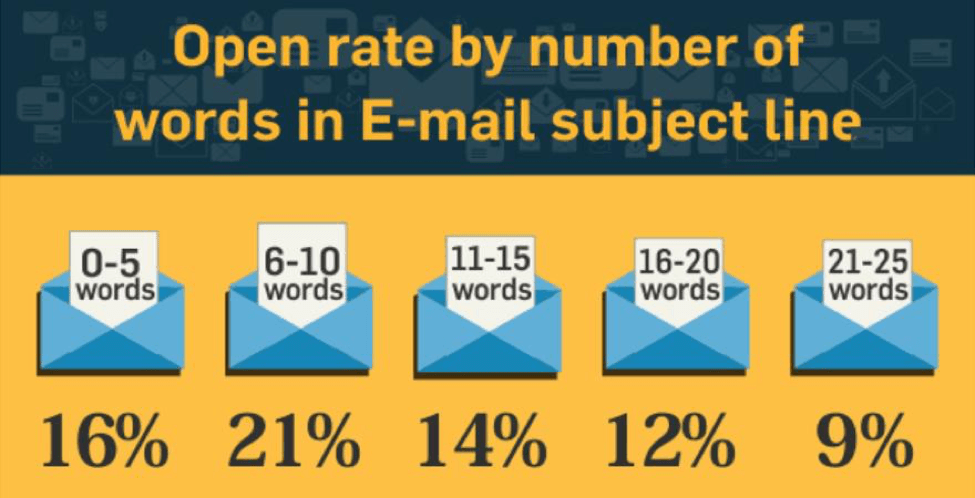
But there isn’t a hard rule, so don’t overthink the word count.
The key is to be straightforward while still being concise and interesting.
Here are some examples of good email marketing subject lines that hit the sweet spot:
- Ready for summer? So are we – See our new swimwear line
- Join Our Loyalty Program to Get an Extra 10% Off
- Get more kitchen space with these 5 quick fixes
- Make them feel special
Use personalization tactics to make your readers feel appreciated.
Call out their name. Tell them they’re a valued customer. Give them exclusive access, sneak peeks, and special privileges.
Examples of good email marketing subject lines to make them feel warm and fuzzy:
- We’re so glad you joined us, Nicole
- Members Only: Access Our Cyber Monday Deals 24 Hours Early!
- Xavier, your private invitation expires tomorrow.
- Show your brand’s personality
If your brand is quirky, don’t be afraid to show it!
Be self-aware, light-hearted, and crack a joke or pun if that’s your style. 🥴
Examples of good email marketing subject lines that keep it fun:
- Are you breaking up with us? Say it ain’t so…
- Woohoo, Your Order Has Shipped!
- 5 authentic Indian food recipes for naan-believers
- Create a sense of urgency and personal investment
I don’t recommend that you always create a sense of urgency, but it can be a great motivator when the time is right.
For example, time-sensitive offers, events, and reminders can encourage people to see what’s inside the email.
Additionally, try appealing to their sense of accountability for themselves and their goals.
For example, emails sent to smartphone owners might include a question to get them thinking about an upgrade or their phone’s performance.
Examples of good email marketing subject lines that motivate and inspire:
- Armando, your prescription is expiring. Time for new contact lenses?
- Final Notice: Buy One, Get One on Mother’s Day Bouquets!
- Are you avoiding these common customer service pitfalls?
Email subject lines are a tricky subject. What works for one recipient might not work for another. Be flexible, test your subject lines, and get creative for the best results.
Email Body Content: Layout, Copy, and Visuals
There are no hard-and-fast rules for what a good email looks like. Some brands like fancy designs while others just use plain text and hyperlinks. This is all up to you, and it’s an important part of telling your brand’s story and building visual recognition.
But there are some basic email marketing design tips that you should keep in mind. We made a handy dos and don’ts chart that highlights key qualities that the best email marketing templates tend to have in common.
Our chart looks at three important elements of your body content: layout, copy, and visuals.
Keep these dos and don’ts in mind.
| DOs | DON’Ts | |
| Layout | • Use an attention-grabbing headline with your main focus, supporting info, then CTA
• Create a visual hierarchy, like headings and subheadings, and different colors and font styles • Use white space (the unused space in the layout) to create a visual balance and direct attention down to your CTA |
• Don’t write big blocks of text – instead, aim to make it skimmable and easy to digest
• Don’t overwhelm with too many colors and font styles – aim for two or three and make sure they match your branding • Don’t make emails too wide, or they’ll be hard to read – about 600 pixels wide will do the trick |
| Copy | • Keep it short and sweet, with each word supporting and relevant to your main focus
• Write clearly and conversationally – use language that’s helpful, descriptive, and actionable • Link to everything that’s applicable to bring them back to your website or landing pages |
• Don’t send the same generic message to everyone
• Don’t use technical words – write as simply as possible so no one has trouble understanding • Don’t focus too much on features of your product or service – instead, show them the benefits and impact |
| Visuals | • Include visuals that are eye-catching, while adding real value to the message
• Format and resize images so that they’re not distorted or blurry when you put them in your template • Remember: there is such a thing as too many images, which might distract from your CTA |
• Don’t include visuals just because you feel like you need to – simplicity is a virtue
• Don’t just use photos – have fun with other types of media like videos, GIFs, and illustrations • Don’t use big media files, which will take longer to load and lose readers’ attention |
CTAs and Buttons
A call-to-action (CTA) is what you want the user to do after reading your email.
You can think of it as the ultimate goal or reason you’re sending the email to begin with.
This could be asking them to use a discount, check out a new product, or read your newest blog post.
The CTA is usually displayed as a button that leads the reader to a webpage (called a landing page) where they can complete this action.
One of the best email marketing call-to-action tips is to focus on a single CTA in each email. By giving one clear instruction, there’s less distraction – which means more action.
Home appliance company Whirlpool learned this first hand. They decreased their CTAs from four down to one and saw a 42 percent increase in clicks.
| 🕒 Tip Time
If you can’t manage just one CTA, choose a primary and secondary one, but avoid using more than two in your emails. |
This email marketing example from City Slickers wants readers to shop for loafers. They’ve made it simple and clear with their “Shop Loafers” CTA button.
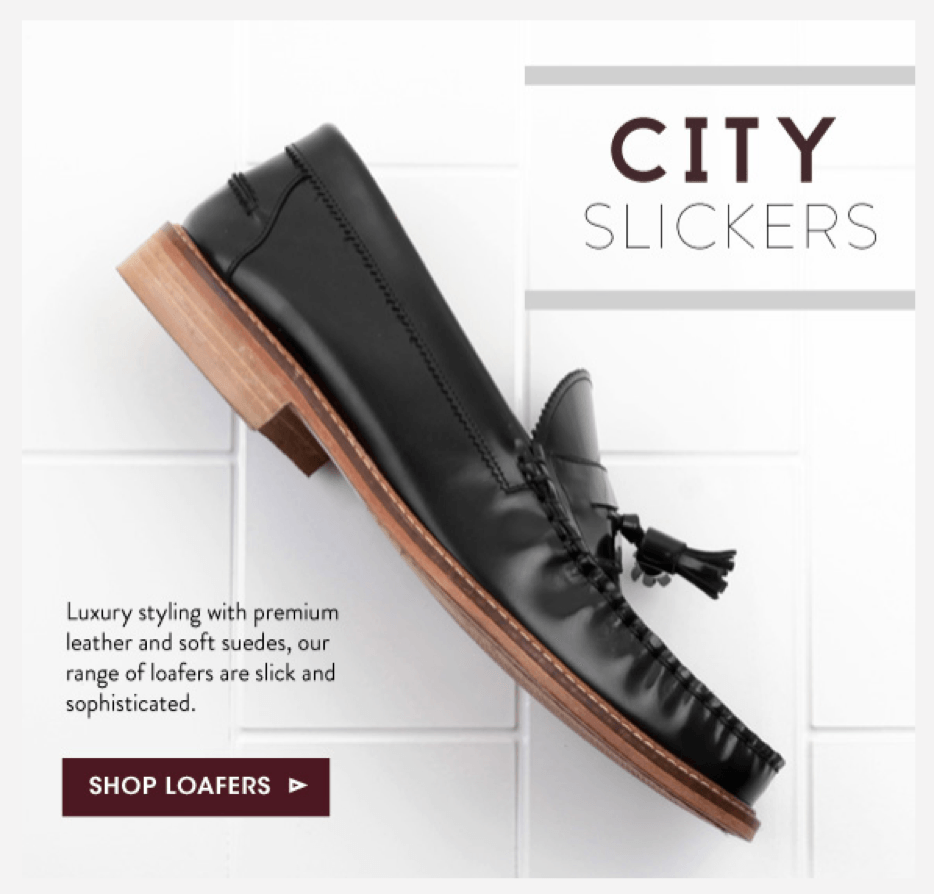
Now that you have an idea of the elements that make a great email, let’s look at the different types of marketing emails you can send.



Types of Marketing Emails
Here’s a list of marketing emails that you can send out to keep your subscribers engaged:
- Welcome emails
- Transactional emails
- Abandoned cart emails
For each type of email, we’ll go over the basics, as well as some more advanced tactics.
Creating an Email Series
An email series includes several automated emails sent over the course of several days, weeks, or even months. You can use your email marketing tool to create one for your campaign.
Common types of email series include:
- Welcome series
- Cart abandonment series
- Post-purchase series
Welcome Emails
Welcome emails are generally the first message you send after you receive someone’s email address. They can be sent after a user takes an action like:
- Signing up for your newsletter
- Creating an account on your website
- Joining a club, program, or utilizing another incentive
- Making their first purchase
It can be a single email or a welcome series.
In this first contact, aim for a specific call-to-action (CTA). For many ecommerce stores, this takes the form of a special discount or promotion.
In this welcome email, fashion retailer Kate Spade offers a discount code for 15 percent off an online or in-store purchase.

If you’re not ready to offer a discount, you can try a different approach. Tell them about a program or offering that makes your brand unique, or direct them to some great content.
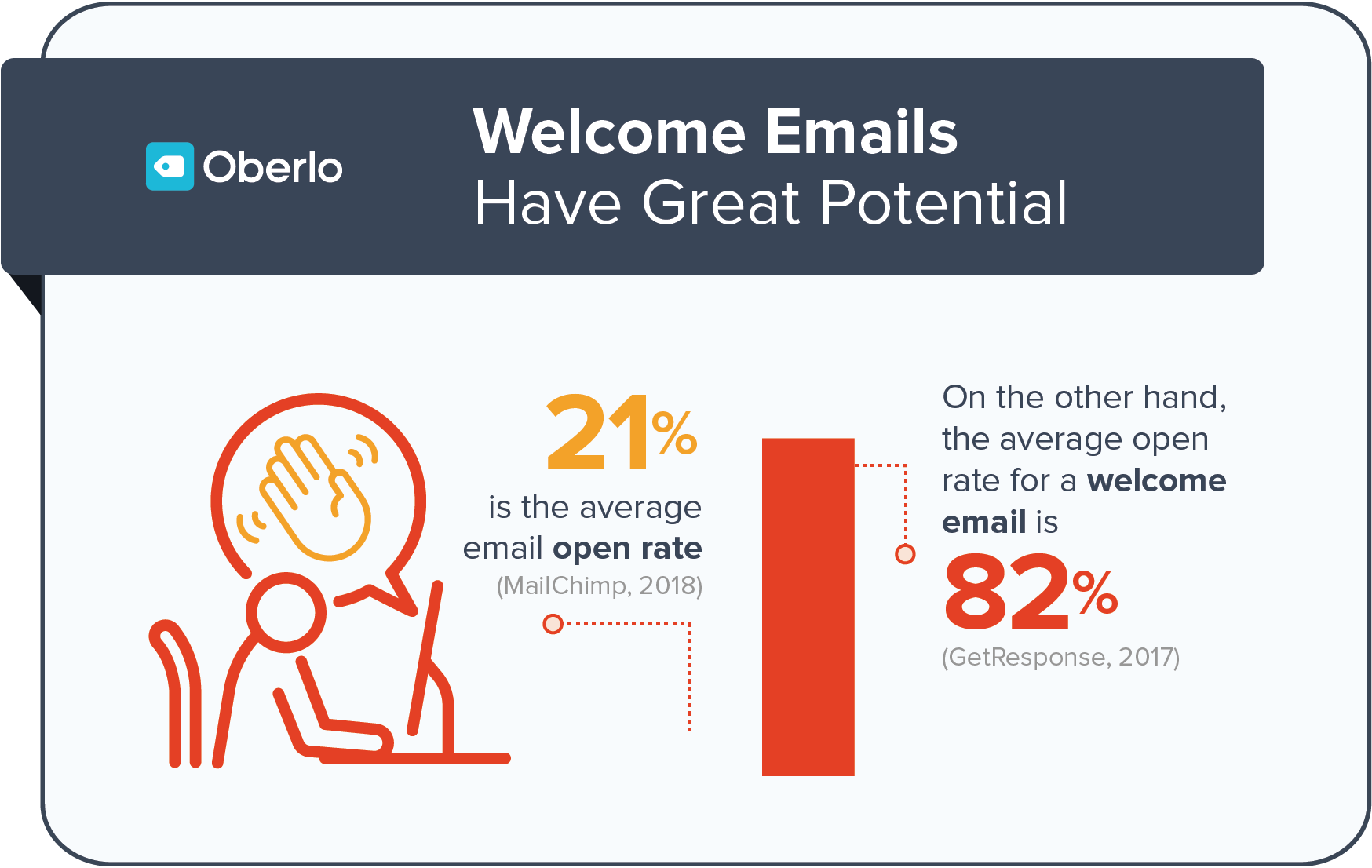
Welcome Series Tips
Say a customer just made their first purchase. A welcome series could have these four emails:
- 1–3 hours after purchase: Introduction. Showcase your company, team, and what you’re all about. Give behind-the-scenes info and photos to make it more personal.
- 3–5 days: Social discovery. Build on your intro email and show the customer how to connect with your brand online – whether that’s social media, your blog, or other channels.
- Two weeks: Product discovery. Shift the message from your brand story to your top offerings. Show off your brand and why people love you. You can also make personalized product recommendations for items related to their purchase.
- 3–4 weeks: Incentive email. Send a discount or other incentive to encourage their second purchase if they haven’t made one yet.
Transactional Emails
Like the name suggests, you’d send a transactional email after a transaction occurs. An example would be a company sending an order confirmation and a receipt after someone buys a product on its website.
The subject line of these emails is typically straightforward like “Purchase Confirmation” or “We’ve received your order.” The email body gives main order details, like:
- Confirmation or order number
- Date purchased
- What exactly was purchased
- Cost of items and total paid
- Payment method
- If there’s a delivery, a note about the arrival
- Shipment tracking number, if possible
Here’s an email marketing example from 1800-Flowers that shows the details of a transactional email:
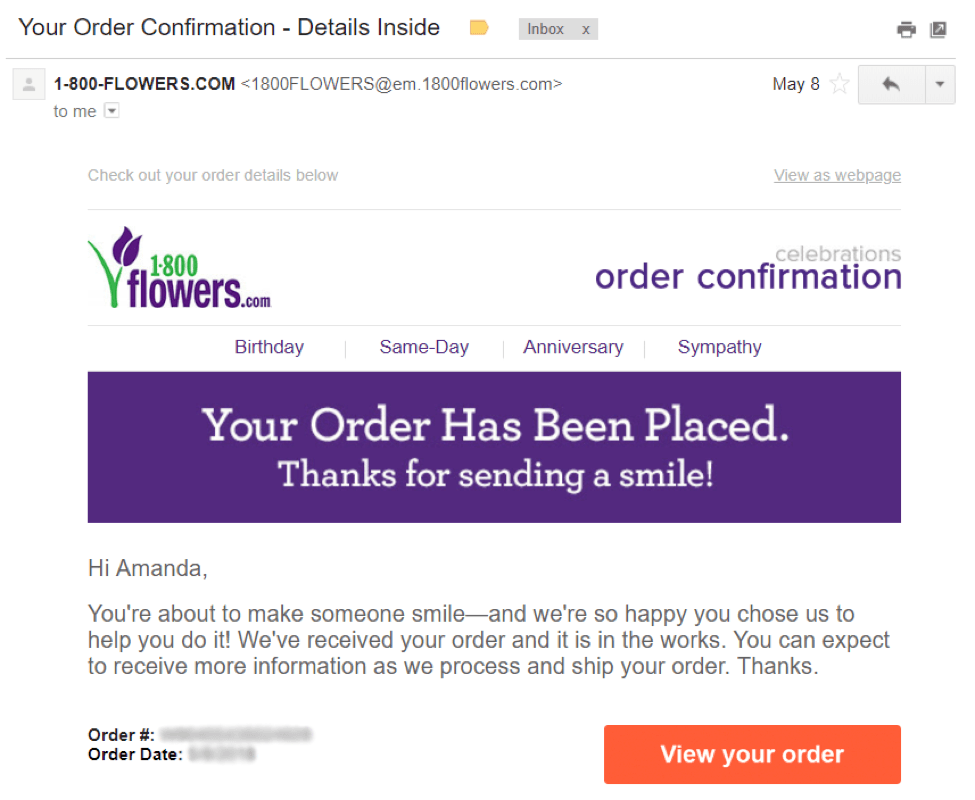
Transactional emails typically one-off emails instead of a series or campaign.
Abandoned Cart Emails
You can use these emails to bring back customers who clicked on the “Add to cart” button, but didn’t go on to purchase the item.
A cart abandonment email should contain:
- A reminder of what exactly is inside their cart, preferably including a product photo of the item(s)
- An easy link to take them directly to the purchase page
- An added incentive to get them to buy now (optional, but effective)
You can also add product ratings for an added boost – it uses the incredible power of social proof to attract and engage customers.
Below is an example of an awesome abandoned cart email:
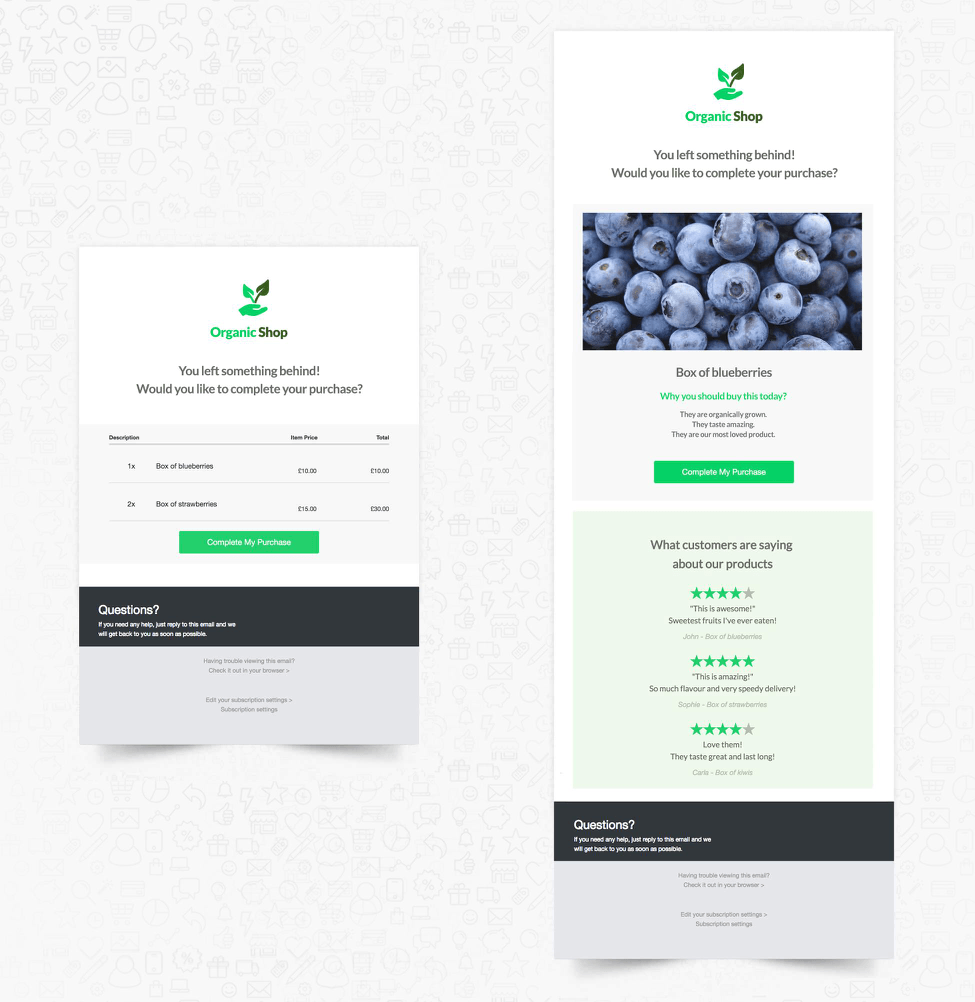
Here’s what makes it so good:
- It includes a beautiful, appetizing photo of the blueberries. Quality food photography really sells, folks.
- It uses three concise USPs (unique selling points) to remind the customer why this product is so darn good and why they need it in their life.
- It includes customer testimonials about related products to enforce the quality of the brand and its products.
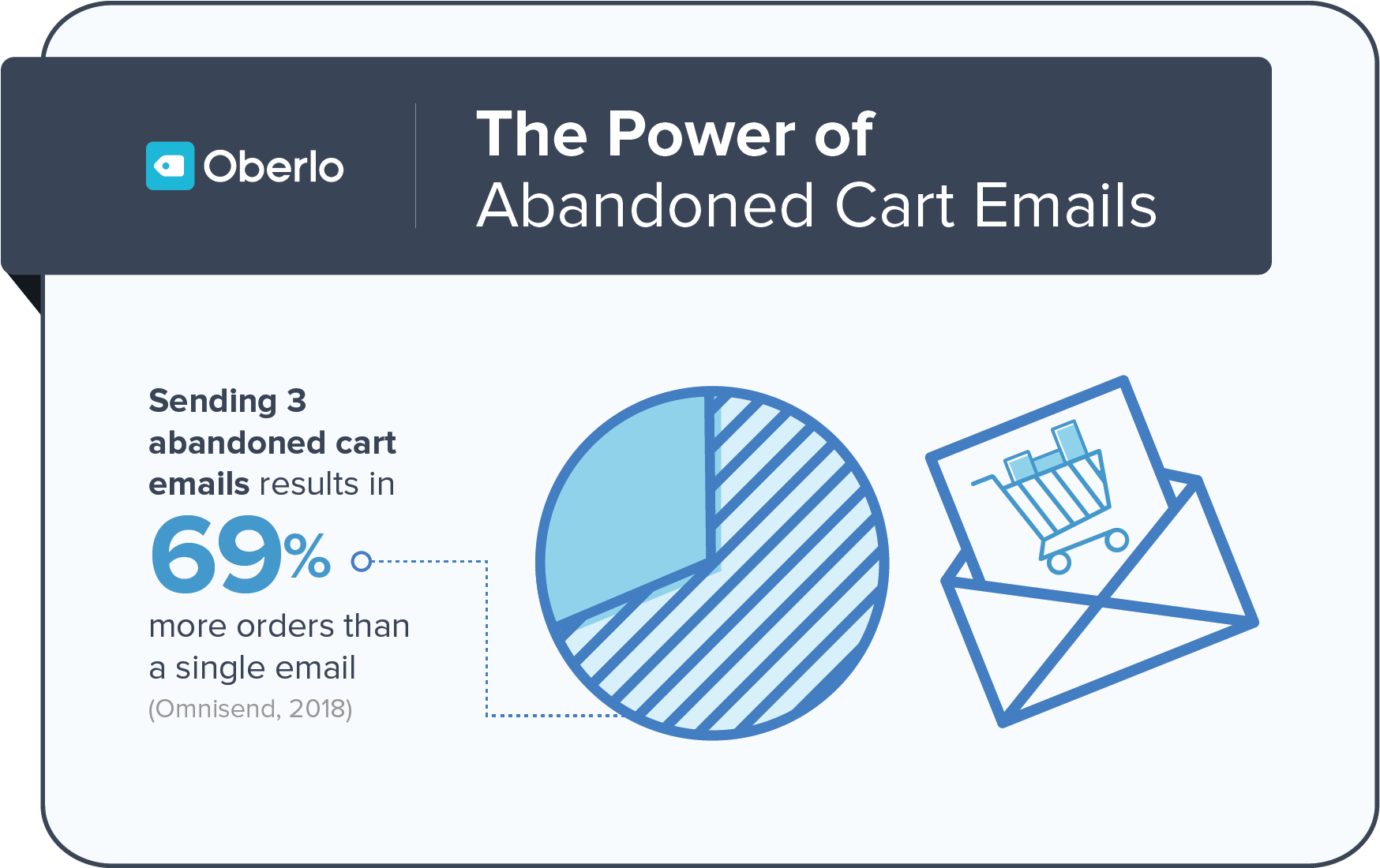
Abandoned Cart Series Tips
Let’s say you want to send a few emails to ensure that you successfully recover an abandoned cart. Here’s a model for a three-email series:
One1 hour after the cart is abandoned: Ask for feedback to figure out why they abandoned the cart. You can then use this feedback to improve their specific situation, as well as possibly make improvements to the whole shopping experience.
- One day: Include a discount or some other type of special incentive to draw them back in. Tell them this offer will expire in three days.
- Three days: Remind them of the discount you sent as email #2, and that the discount will expire today.
| 🏆 From the Pros
Yuliya and Mike also use a welcome email series along with abandoned cart emails. “For the welcome series, we send people a series of messages three days in a row. With abandoned carts, we’ll remind them that they have an item pending in their carts. We’ll also include reviews so people can get social proof. People may not purchase because they don’t trust you, so you can send them reviews. We have the process pretty well optimized, and it helps us retain 10 percent of our abandoned carts, which we turn into purchases.” |
Post-Purchase Email Series
You can use this email series to get recurring sales for your business. 💸
The post-purchase email series is a general marketing strategy that can apply to anyone who has made a purchase (though you’ll still want to personalize certain details, like the item(s) you offer as an up-sell).
Here’s an example of a post-purchase series that lasts four weeks and includes six emails:
- Immediately after purchase: Confirmation and purchase receipt. This is a standard transactional email to confirm their order. Adding a discount to the receipt email can be massively successful, so consider this too. Set the expiration of the discount anywhere up to two weeks.
- Three days after purchase: Get feedback. If they bought a physical product, be sure they’ve received it in this window so you can ask them about their purchase and delivery experience. Are they unhappy? Learn why and try to make them happy again. Are they happy? Use that data for a testimonial!
- 1–2 weeks: Product reviews. Send this one after they’ve had enough time to actually start using the product or service they bought. Direct them to a dedicated web page where they can review the product.
- One day before discount expiry (2=two weeks): Discount reminder. If you offered them a discount in their purchase receipt email, remind them that they’ve only got 24 hours left to use it.
- 2–3 weeks: Cross-sell. Send 1–3 personalized product recommendations based on their purchase.
- Four weeks: Another discount. If they’ve made another purchase, send a promotional email, like offering an added discount for referring a new customer.
👉 Without question, email is still a powerful tool to use for engaging your customers. Consider combining email marketing with the tactics in Chapter 10 to give more exposure to your business.
